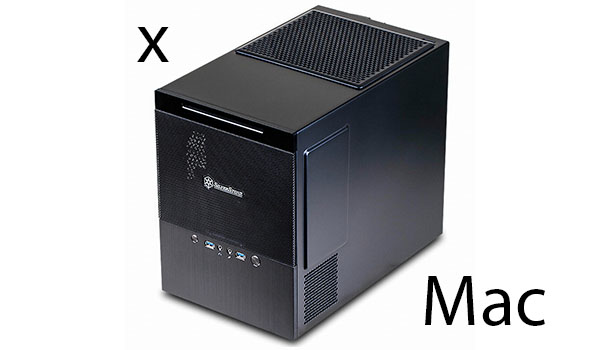
Ever since the introduction of the first Power Mac G5 towers, a number of Mac users have been holding out hope for a mid-range machine that would offer more expansion and upgradability than an iMac, at less cost than the a Power Mac G5 (or later Mac Pro). Ars Technica’s John Siracusa gave this elusive product a name: the xMac.
The basic premise of the xMac of course was that we needed a Mac that was both semi-affordable (not huge was nice too) and at the same time somewhat future-proofed. The iMac for all its virtues has never been a particularly friendly machine for upgrading and has only gotten worse with time. These days, even changing the hard drive is a pain, and of course if the display goes, you’re hosed. The Mac Pro meanwhile has always been pretty good on the expansion front, but it’s hard to justify paying $2500+ when a much less expensive machine would work equally well for my tasks. Plus recent rumors notwithstanding, Apple seems to have more or less abandoned the Mac Pro at this point, leaving it woefully outdated (CPUs are 2 generations out of date, machines lack Thunderbolt, etc.).
Since the xMac never materialized and funds were scarce, back in early 2010 I built my own PC from components, and then finagled Mac OS X onto it. Legal gray areas aside, that solution has worked pretty well for me, and after more than 3 years the machine is still working nicely – in fact I just installed MacOS X 10.9.
The hackintosh route proved quite definitively the virtues of having an easily upgradeable machine. When my storage requirements (thanks to all the photos I’ve taken) grew beyond 1TB, I was able to add a second drive and not to pay a premium for the newer (and then untested) 3TB drives. When SSDs finally reached the point of affordability, I could add one without having to remove an existing drive. When external backups began to bog down due to too many large files being updated, I bought a $20 USB 3.0 card and a $15 USB 3.0 enclosure and was able to speed them up by a factor of 2.5x.
Compared to having an iMac, I saved a great deal of money and headache. I was able to use my existing 23” IPS display and not have to pay for a monitory I wouldn’t use (the built-in iMac 24” glossy display is not nearly as good as what I already had). Hard drive installation was a 2 minute affair, and I could have more than 1 at a time while keeping my optical drive. With the iMac, upgrading to USB 3.0 would not even have been possible.
Of course the Mac Pro would have been able to do all of these upgrades (and more). But the Mac Pro would also have been overkill. My most performance intensive program (Adobe Lightroom) doesn’t benefit either from gigantic quantities of memory or more than 4 cores. For $1000, my machine served me just as well as the Mac Pro would have, at nearly 2.5x the cost. Mind you, I realize that an Apple machine will never cost the same as a custom-built one, and I’m perfectly willing to pay a premium for an Apple-designed and supported machine, but a premium would be something like 35% more, not 150%.
At this stage, my machine is starting to feel a little long in the tooth, so I’m looking to upgrade. But the situation is the same as it was in early 2010. There’s no Mac that’s reasonably upgradeable for less than $2500, and that’s a price that just won’t fly. So I’ll probably build another machine, just like I did before. And since the case, power supply and memory are all compatible with the newer motherboards and CPUs, I expect it’ll cost even less than the last time around.
